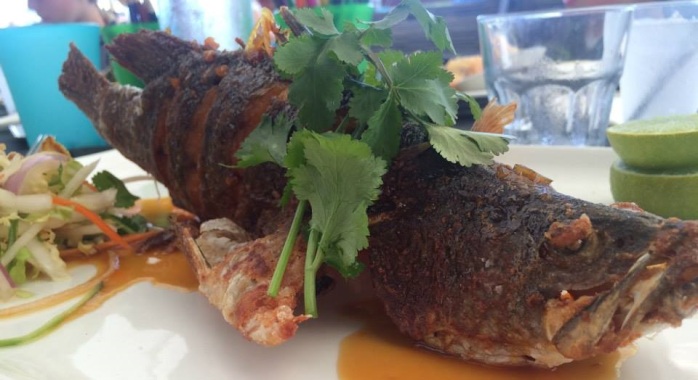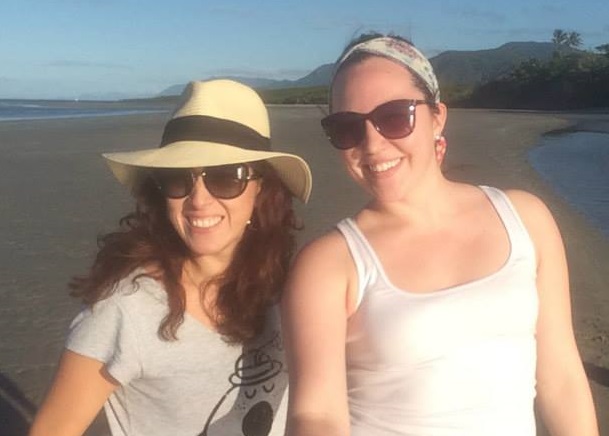Reluctantly, we have returned from our holiday in warm, beautiful Port Douglas, Queensland and are back in cold (but still beautiful) Melbourne, Victoria.

We stayed in a villa hidden behind the line of swaying palm trees along the famous Four Mile Beach. At low tide, a vast expanse of the intertidal zone is exposed or under very shallow water, thus allowing beach goers to observe hermit crabs, sea stars, and small fish up close and personal.

Queensland, like Victoria, did not disappoint in the food department. Located at the Reef Marina is a restaurant, On the Inlet, that serves everything from basic fish n’ chips to seafood platters topped with crab, scallops, and calamari to pan-seared baby barramundi with an Asian salad (pictured above). Enjoy it all while watching the boats sail along the inlet into the horizon.

On Thursday, I returned to my natural habitat. At 10:00 AM, we boarded the Quiksilver and took a scenic cruise to Agincourt Reef, one of the 2,900 small reef ecosystems that comprise one of the seven natural wonders of the world, the Great Barrier Reef. Upon docking at a large pontoon in the middle of the Pacific Ocean, as always, I took to my fins and dove into the spectacle of the sea. I have done my fair share of snorkeling, but there are always new things to see and discover. Whilst frolicking the sea as a mermaid, aside from the easily recognizable parrotfish, clownfish, and angelfish, I saw, for the first time: giant clams, a humphead wrasse, blue linckia sea stars, and orangespine unicornfish, to name a few.
It was an early start Saturday, as we boarded a 4WD bus that would carry us from Port Douglas into the Daintree Rainforest, one of two World Heritage Sites I would experience during this holiday (the Great Barrier reef being the other). We began by driving through Mossman Grove, a small town where the sugar cane plantations seem to outnumber the people (population 2,000). Sugar cane is a year-long crop that is harvested for three to four months before being transported, via railway, to the mill for processing. The small street housing the supermarket, cafes, and laundromat is the hub of Mossman Grove. “Moss Vegas,” they call it. If you are in need of any major purchases, you must travel some 30 to 45 minutes to Port Douglas to retrieve them.
Our first expedition was a river cruise along the Daintree River which spans 140 km (87 mi) north of Mossman Grove. The river is an estuary (brackish water where salt and freshwater mix) and its mangrove and eucalyptus lined banks are home to many animals, such as: barramundi, yellowbellied sunbirds, herrings, and the animal of the hour, estuarine crocodiles.

Saltwater crocodiles are energy efficient animals, obtaining all their energy from the sun and using their food sources solely for growth and development. They can survive without food for up to six years and without water for up to two months. Saltwater crocs can slow their heart rate to two beats per minute which allows them to stay under water for up to six hours. Females reach lengths between two and three and a half meters, while males reach lengths up to eight meters. Scarface, one of the twelve crocodiles spotted during the cruise, is the alpha male along the Daintree River. He is near 70 years of age, 4.7 meters length, and 600 pounds. Due to fighting other males in territorial disputes, he has lost all 2,700 teeth allotted in his lifespan. He is one tough animal I would not like to swim with.

The Daintree Rainforest is the oldest rainforest on Earth and houses Australia’s greatest biodiversity. It has been accessed by non-natives since the 1800’s, but no efforts to protect it were made until the 1960’s when the rainforest was deemed a World Heritage Site. Cassowaries (literally translated, “horned heads”) are large, colorful, flightless birds that aid in the dispersal of seeds, thus enabling the growth and development of the forest. Cassowaries occupy the understory with orange footed scrubhens, a small bird which builds the largest ground nest; while bennetts, or tree-climbing kangaroos, and other smaller birds can be found in the canopy.
One must be very self-aware while trekking through the forest, for there are several types of dangerous fauna among you. Be aware of the Hope’s cycad’s grayish speckled palm fronds, for its entire composition–bark, leaves, and seeds–is toxic to humans. The seeds of these trees take 12 months to germinate; and once sprouted they grow approximately one meter every 100 years. Hairy Mary’s are trees that are sure to pierce the skin should you grab hold of its spike-covered trunk. Lawyer bushes, or wait-a-whiles, will have you waiting, if its spiky vines latch onto your skin or clothing.

Our last stop within the Daintree forest was Emmagene Creek, a natural water hole, where some brave tourists enjoyed a nice (chilly) swim followed by an exotic fruit and Billy tea tasting.

(1) sour sop, sour custard apple; (2) rollinia, sweet custard apple; (3) black capote; (4) Indonesian apple, five corner; (5) papaya; (6) sapodilla, caramel pear.
Of the exotic fruit, I most enjoyed the sour sop (1); it tastes similar to lemon meringue. Despite the off-putting appearance of black capote (3), it wasn’t bad; it was creamy, but bland making it the least enjoyable.
Billy tea is tea brewed using an aboriginal technique to ensure tea leaves are not scooped into drinking cups. Once the tea leaves are done boiling in the billy pot, a person swings the pot in a circle several times, allowing centripetal force to pull the tea leaves to the bottom of the pot. A stick is then banged on the side of the pot forcing any stray leaves to sink to the bottom. The tea can then be scooped into cups to drink, leaf free!

In 1770, James Cook ran his ship aground at modern-day Cape Tribulation, named for “the beginning of [his] trials and tribulations.” Cape Tribulation is the converging point of two World Heritage Sites, the Daintree Rainforest and the Great Barrier Reef. It is a spectacular scene, lined with palm trees and mangroves, with an undisturbed view of the horizon. Not enough time was allotted to bask in its beauty.

Lastly, we ended our excursion with a stop for ice cream, freshly churned passionfruit, raspberry, pineapple, and wattle seed ice creams. Nothing beats the sweet, chilly goodness after a day of traipsing in the hot sun.
Our final day in Port Douglas was spent meandering around a market. Vendors lined a field by the marina, selling handmade goods–artwork, jewelry, and clothes. We witnessed the crushing of sugar cane to make juice, the playing of a didgeridoo by an aborigine, and an array of other street performers.

Our return flight to Melbourne did not leave until late evening; so before checking into Cairns Airport, we visited the Cairns Tropical Zoo, where I got to check off another item from my bucket list. Yep, I cuddled a koala; two and a half year old, Charlie! Despite what I had been told, he was heavier than I thought he would be and less smelly.

All good things must come to an end, but I can say with confidence though, this holiday will not be my last venture to Australia’s Sunshine State. My heart calls to the sun, sand, and sea. So, until next time, Queensland.
xo

I cannot say “Thank you” enough to my fabulous host mom, Sole, for allowing me to join her and her family on this amazing holiday. She has welcomed me into her home and has treated me with nothing but kindness since my arrival. I had a blast during the entire trip and seeing the boys expressions and excitement for all the world’s wonders is something I will truly remember forever. I love being the go-to girl for all their marine-related questions. I’m ready to move, when you are, Sole! 😉

I want Charlie!!! Can you kidnap him and send him to me for Christmas?? 🙂 Sounds like a fun-filled vacation. What an opportunity.
LikeLiked by 1 person